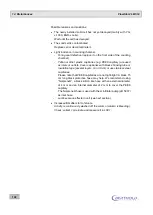
FlowStar2 LB 514
13. Explanations
119
13.2 Efficiency Correction
The efficiency correction is affected by the parameters 5. through
12.
By taking into account the empirically determined static and dy-
namic efficiency, the cpm or cps values calculated as a function
of the ratemeter unit can be converted such that the activity flow
is output in dpm/min or dps/min; with a time axis in minutes the
integration of the peak area results directly in the activity con-
tained in the peak. In the following we will assume that the
ratemeter unit has been set to minutes, so that we will get
cpm/min or dpm/min. With the ratemeter unit seconds, cpm has
to be substituted by cps and dpm/min by dps/min.
Essential requirements for the activity calculation is the correct
calculation of the net cpm values, i.e. the values for the back-
ground rates and the spillover factor must be determined cor-
rectly and entered accordingly for the inquiries 5. - 7. The net
cpm values are calculated as follows.
cpm
net
= cpm
gr
- Background [cpm]
dual Ch cpm
net
= cpm
gr
- Background [cpm] - H-cpm
net
Spill
Ch1
Ch2 [%]/100 [%]
These formulae show that for dual channel measurements the
net cpm value of the higher-energy channel must be calculated
first, since this value is required for the spillover correction.
For single channel measurements the formula is identical to the
first formular mentioned above:
cpm
net
= cpm
gr
- Background [cpm]
If one gets negative values for the net cpm, they will be set to
zero for output or further processing.
The calculated net cpm values are now used for calculation of
the activity flow according to the following formula:
l
Vol
%
Eff
l/ml
1000
%
100
ml/min
)
F
+
(F
=
min
Sc
El
dpm/
where:
F
El
:
eluate flow coming from the HPLC system
F
Sc
:
scintillator flow (only relevant for admixture cells)
Eff:
static efficiency of the installed measureing cell
Vol:
volume of measuring cell taken from the cell ID chip.
Through integration of the activity flow over the entire peak one
gets the activity of the individual peaks. With a time axis in
minutes, the activity in dpm corresponds to the area of the peak.












































